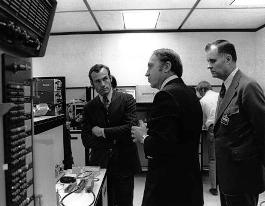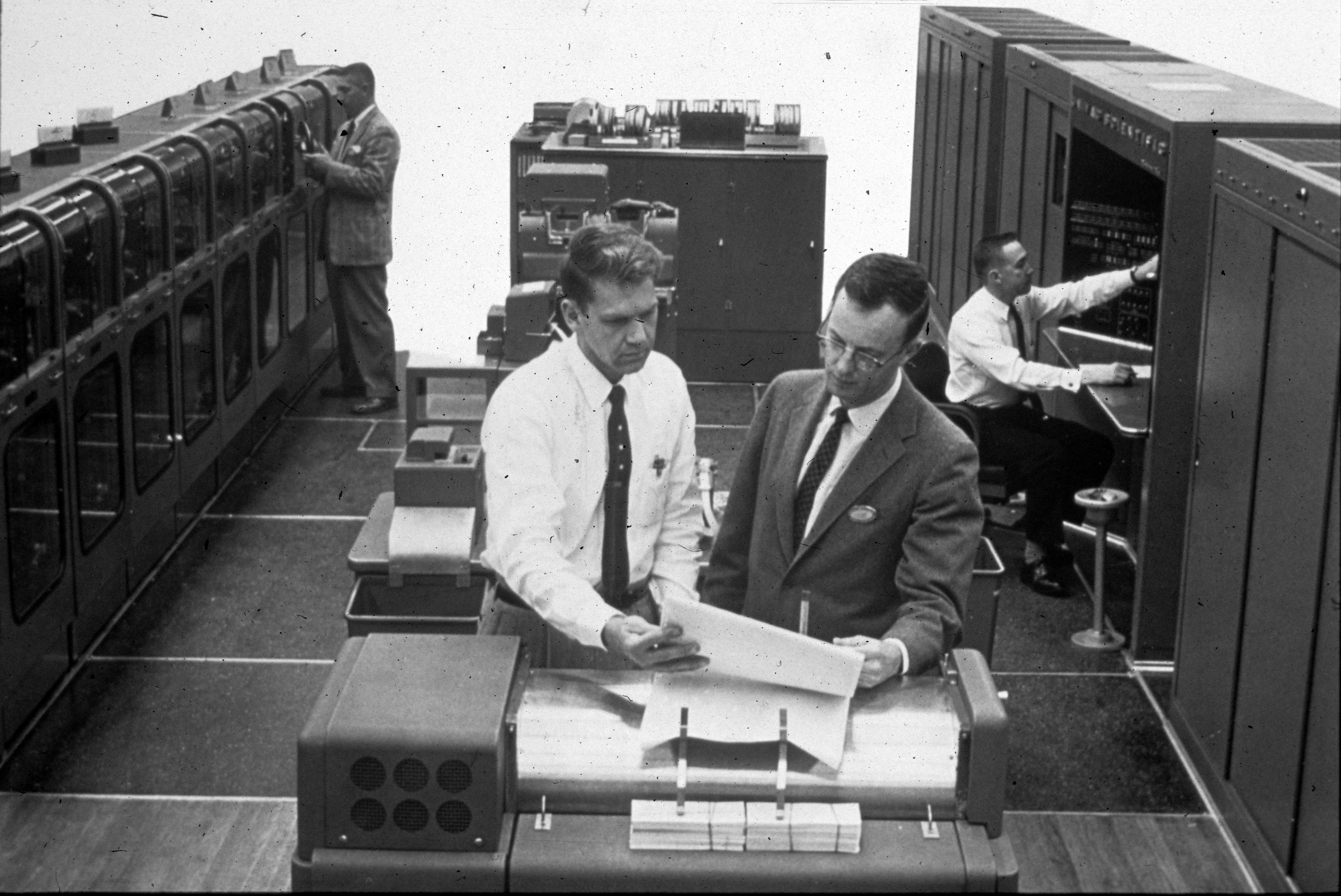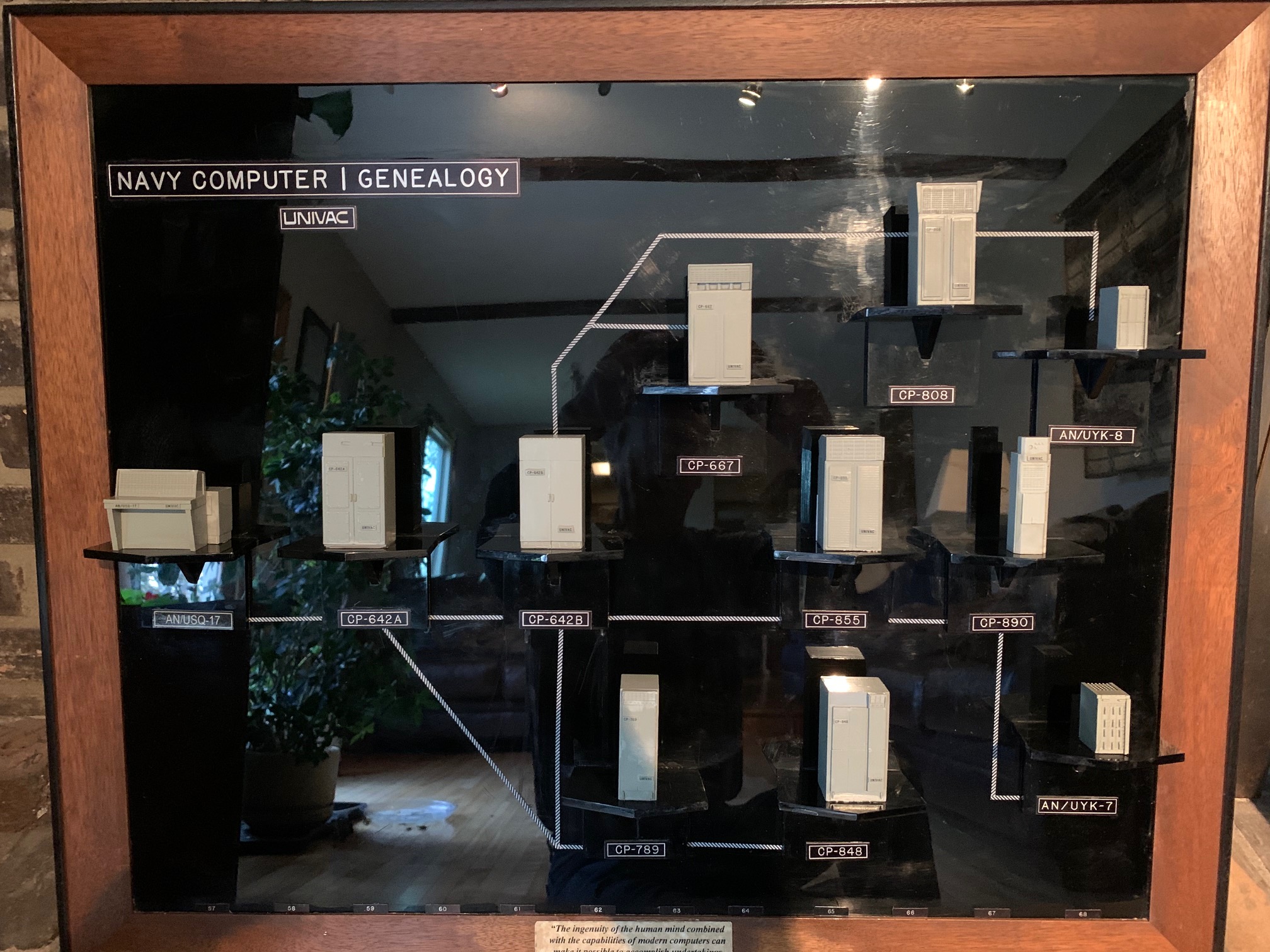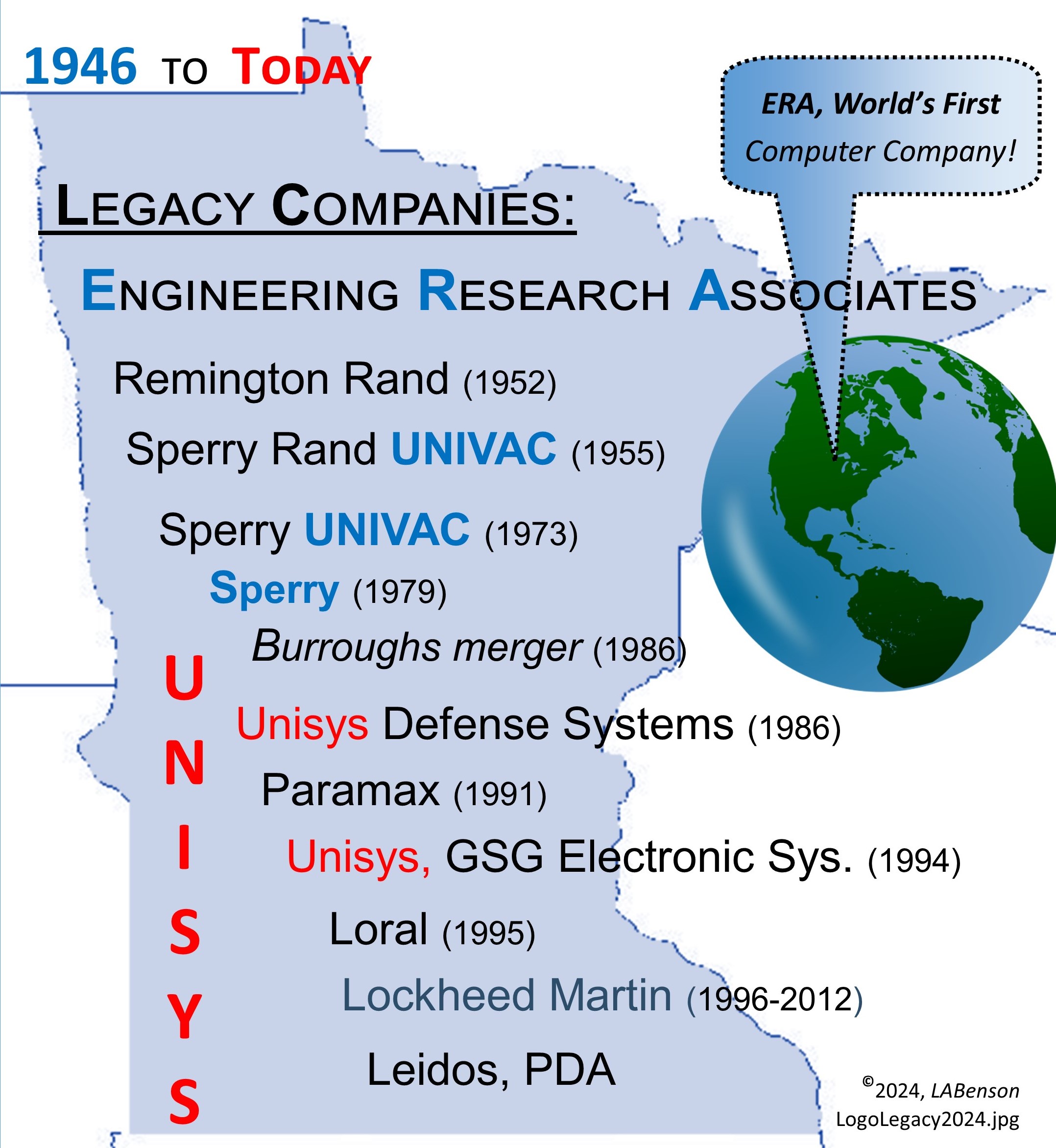

Information Technology (IT) Pioneers
Retirees and former employees of Unisys, Lockheed Martin, and their heritage companies
Computers, Chapter 50
 This 1975 photo shows CA Congressman, Barry Goldwater Jr. listening
as Engineering Manager, Marc Shoquist [center] explains computer technologies in front of a 1219 computer
in the plant 1 military computer center. General Manager Dick Seaberg [right] watches.
This 1975 photo shows CA Congressman, Barry Goldwater Jr. listening
as Engineering Manager, Marc Shoquist [center] explains computer technologies in front of a 1219 computer
in the plant 1 military computer center. General Manager Dick Seaberg [right] watches.
1. Introduction
Our computers span several technology generations: Vacuum tubes,
magnetic logic circuits, transistors [germanium then silicon],
integrated circuit Diode Transistor Logic (DTL), Transistor Transistor
Logic (TTL), and Emitter Coupled Logic (ECL)], followed by Application
Specific Integration Circuits (ASIC) then embedded microprocessors
as technologies evolved.
Memory
technology generations in our computers evolved from magnetic drums
through magnetic core, deposited
film, plated wire, core rope, MNOS, CMOS RAM and ROM, and EEPROMs -
read more in our Memory chapter.
In the 13 years from 1947 to 1959, the St. Paul Division of
Remington Rand Univac produced over a hundred electronic and
mechanical products ranging from large-scale data-processing systems
to miniature comuter components.
PX1477 describes these products.
The nine computer sub-chapter tabs are titled by bit length or use; most of the machines within a bit length share an Instruction Set Architecture (ISA).
2. Computers' Chapter Sub-tabs:
The 'name' of our computers varies greatly depending upon the situation. In many cases they are referred to by their company type number, i.e. 1100 series that started with the 1101 assigned to the public version of the then classified ATLAS computer. In other cases the assigned military designation is used, i.e. the first Naval Tactical Data Systems computer was the AN/USQ-17. A Defense Systems summary and comparison booklet from the 70's was scanned.
24-Bit Machines - The 24-Bit units were
first used for cryptography, then missile launch, then mostly on-board
missiles guidance computers plus a few specialty machines.
30-Bit Machines - The
30-Bit units were initially developed for the Naval Tactical Data Systems
shipboard environment - subsequently used by Marines, Navy Air systems,
and the FAA. Actually the first 30 bit machine was the special purpose 1102
developed for the Air Force to automate data collection for their
wind tunnels at Arnold AFB.
18-Bit Machines - The 18-bit units were
mostly aboard surface ships, used for radar beacon tracking and logistics
support, plus Talos, Tartar, Terrier missile launching. Then for FAA
transponder processing.
32-Bit Machines - The 32-Bit units
were used in Navy Shipboard and Navy Airborne systems, multi-processor
technology updates to the unit processor 30-bit architecture in the
70's.
36-bit Machines - The ERA 1103 and 1105 were
36 bit machines leading to the commercial 1100 series - the commercial
applications of the Philadelphia developed UNIVAC machines are handled
on the Legacy, EMCC to UNISYS chapter.
16-Bit Machines - The 16-bit units were used
in Navy, Army, and AF systems, multi-state technology replacements to
the 18-bit single state architecture.
Air Force Machines - The Air Force Central
Processing Units (CPU) were both 16-bit and 32-bits as well as a couple
of tailored systems.
Other - We've done some digital trainers
as well as Embedded COTS (Commercial Off The Shelf) micro-processor
based hardware units which are being used in either shipboard or airborne
systems.
Commercial Processors - This shows
the 1100 series line as well as the RCA, Burroughs, and other merged
computer lines. [LABenson]
3. Computer Genealogy
This 1968
chart segment illustrates our computer lineage over the first two decades,
download to print from
http://www.vipclubmn.org/EngDocImg/Univac%20Computer%20Genealogy.pdf.
The green and yellow 'boxes' are defense industry units that
originated in St. Paul, MN. The orange boxes are
'commercial' computers from St. Paul except for above the footnotes
on the left are the three computer units that originated at Norwalk,
Connecticut (409, UNIVAC 60, and UNIVAC 120) and the UNIVAC I,
UNIVAC II lineage that originated at
EMCC in PA.
Also, the three File Computer 'orange boxes' are preceded by the Flight
Plan Storage System.  Mark Greenia of the Computer History
Archives Project sent us the photo on the right asking us to
identify it. Engineer Jack Hill is standing at the left of the operator console.
Mark Greenia of the Computer History
Archives Project sent us the photo on the right asking us to
identify it. Engineer Jack Hill is standing at the left of the operator console.
 At the Lawshe Memorial Museum, volunteer Keith Myhre found a console photo
and extracted the name plate image, shown at the left. CAA was the predecessor to FAA. Many of the File Computer units were installed at Enroute Centers
to track and control civilian air craft traveling between airports.
These systems preceeeded the Automated Radar Terminal(ARTS), reference the charts bottom line at the
Air Traffic Control chart at our ATC systems chapter.
At the Lawshe Memorial Museum, volunteer Keith Myhre found a console photo
and extracted the name plate image, shown at the left. CAA was the predecessor to FAA. Many of the File Computer units were installed at Enroute Centers
to track and control civilian air craft traveling between airports.
These systems preceeeded the Automated Radar Terminal(ARTS), reference the charts bottom line at the
Air Traffic Control chart at our ATC systems chapter.
A Sperry UNIVAC defense computer sequence is are shown on a GenealogyUnivac2.pdf file which will open in a separate window {Editor's note: If the reader increases the scale of the Adobe reader display, it is easier to read the charts.} On this genealogy charts, a four digit number [such as 1103, 1224, 1830, 1219] is the Univac type number. A label [such as AN/USQ-20B or CP-901] is the military nomenclature as requested by the project. A number in parenthesis [such as the (361) after the 1219B] is the quantity delivered. }
A more legible on-line two page genealogy of the St. Paul computers is
Genealogy Univac, developments through 1993. A two part commercial
computer tree supplements this defense computer genealogy. Not shown on these charts are the Nike intercept computers,
described in an article by George
Gray nor the
special purpose
machines described by John Alton and Wayne Olson in the Special Computers
chapter.
ERA Publications
- In 1948 ERA described a 30-bit machine.
- In 1949 ERA conducted a digital computer seminar.
- A 1950 1101 Technical Memorandum.
![]() ERA 1103 photo at right is from the
Bit-Savers web site.
ERA 1103 photo at right is from the
Bit-Savers web site.
4. Genealogy chart comments by Harry Wise
- Transtec I and Magstec I were test beds for transistor and magnetic core logic. They were not computers but a rack of self testing logic.
- Transtec II and Magstec II were 24 bit stored program computers. Each had 4,096 words of core memory. They were program compatible. They could be considered a follow on to the 24 bit Atlas/1101 vacuum tube computers. They remained around the plant for years being used for all sorts of things. The Transtec II was in the back room of the Plant 1 Military Computer center in the 60s, shared space with the card key punch machines.
- Athena preceded the NTDS project, it was a 24 bit machine.
- Bogart preceded the NTDS project. I used the prototype to run a simulation of the NTDS radar Video Processor. While Bogart itself was not classified, its use was. It fits much better in the military side of the house, I think. It was designed by Carl Kohler. It was a follow on to the Magstec II. Bogart was a 24 bit machine with an instruction format closer to the 30 bit NTDS machines than to its predecessors. Bogart was extremely reliable for its time.
- The AN/USQ-20A was a follow on to the AN/USQ-17. The M-460, I think, was a machine that was designed but never built {Editor's note: Ernie Lantto confirms that no M-460 hardware was ever built, however - Winnipeg's history shows that they manufactured printed circuit cards and modules for an M-460.}
- The NTDS project designed the architecture of two machines, one 30 bit and one 36 bit. The 36-bit was never built for the military but the 36 bit machine became the Univac 1107.
- The Univac 422, the training machine was the first of the “half size” machines. Initially it was to be an 18 bit machine but was cut to 15 bits to save money. Nice try on an 18 bit machine. First try.
- The commercial Univac 490 was a mostly mechanical and I/O amplifier rework of the AN/USQ-20 30 bit NTDS Service Test Computer. The logic design remained and the memory was speeded up to first 6 microseconds and then to 4.85 microseconds. [From the original 8 microseconds.]
- A spin-off of the Univac 490 was the Control Unit Tester (CUT), the first of a series of 18 bit machines in the 418/1218/510/580 line. The CUT was just what its name implies – it was intended for testing peripheral control units in manufacturing for the Univac 490 and the Univac 1107 systems. Due to long forgotten design problems it was redesigned before it became the 418. Jim Ketchum knew the machine well enough that he used it for years in Plant 8. Second try.
- The 18 bit line really got its start when Univac sold the 418 bit architecture to Westinghouse for them to brand as the Westinghouse Prodac 510 and Prodac 580. They were the same machine with fewer options in the 510. Many of the cards in the Prodac machines were labeled “418”. Third and fourth tries and finally.
- The Univac 418 was the commercial 18 bit machine that had a hard time making it through the Blue Bell, PA management. Blue Bell management did not want to be in the “mini computer” business, in spite of the fact that the 418 was more powerful than the Blue Bell machines. At this time DEC was just getting started in the mini computer business. The 418 was a much better machine.
- The Control Unit Tester, the 1218, and the 418 were all intertwined. This was the second time that Univac had both a military and commercial version of the same machine. Only the reverse this time, from commercial to military.
- There was a large missile control machine that Univac designed for AT&T. I will eventually remember its name. Jim Nelson worked on it. I think Earl Joseph worked on it also. {Editor's note: This may have been the Nike Intercept Computer.}
- There was a large totally classified machine that is missing from the late 1950’s. Chuck Eddy, retired out west some where, is the only person I can think of that worked on it. Come to think of it he worked on some of the “others” as well. Jerry Neese is another person that worked on a bunch of that early stuff. He programmed a simulation about 1959 that was years ahead of its time. He is retired in Salt Lake City.
There were a lot of systems that should be covered. The 1102 was the world's first process control machine, first Local Area Network and a bunch of other things. The committee should talk to Don Edam about the world wide communications system for NASA. Or the airlines reservation systems in the mid 1950s. NTDS had to be the cherry on top. [Harry Wise]
5. NTDS Computer Models:
Have you read 'When Computers went to Sea - The Digitization
of the U.S. Navy' by Capt. David Boslaugh, IEEE Press?
It tells
the early history of the Naval Tactical Data Systems (NTDS) while explaining
development of the computers depicted by these ten models.

The models were donated by Lowell Benson who found them in the store room of a New Jersey marketing office which was being closed in the early 80s. The model scale is approximately 1" = 2'. Left to right, these are the AN/USQ-17 [type M-460], CP-642A[type 1206], CP-642B [type 1212], CP-667, CP-789/UYK-5 [type 1218], CP-808 [type 1213, MTDS], CP-848 [type 1219B], CP-855 [type 1230, NASA], CP-890 [type 1289], and the AN/UYK-7 [type 3250].
Table data below is from an 8 June, 1981 DSD Computer History Summary.
| Mil Type | AN/USQ-17 | CP-642A | CP-642B | CP-667 | CP-789 | CP-808 | CP-848 | CP-855 | CP-890 | AN/UYK-7 |
| 1st /delivery | Spring 1958 | September 1961 | February 1963 | 2/20/1964 | 4/1/1963 | 9/14/1964 | 5/25/1965 | 7/30/1965 | 6/7/1967 | April 1969 |
| Customer | BUSHIPS | BUSHIPS | BUSHIPS | NEL | Navy | USMC | BTL | NASA | USN-SSM | NAVSHIP |
| Total Built | 6 | 143 | 239 | 3 | 326 | 19 | 367 | 120 | 164 | 1000+ |
| UNIVAC Type | M460 | 1206 | 1212 | ?1236 | 1218* | 1213 | 1219B | 1230 | 1289 | 3250 |
| Nick Name | Q-17 | NTDS | 20B | MTDS | Talos*** | C3**** | ||||
| Comments | Note 1 | Note 2, 3 | Note 4 | Note 5, 6 | ||||||
| Specification | DS4601 | DS4654 | DS 4781 | DS4769 | DS4836 | |||||
| Weight/Lbs | 2200 | 2320 | 2400 | 2010 | 950 | 1750 | 1200 | 2100 | 750 | various |
| Vol/Ft3 | 54 | 54 | 54 | 62 | 32 | 54 | 33 | 60 | 21.1 | Note 5 |
| Power/W | 2500 | 2000 | 2500 | 4200 | 1500 | 3500 | 2000 | 3500 | 2150 | various |
| Module Size | 1.5"x2.5" | 1.5"x2.5" | 1.5x2.5" | 1.5x2.5" | 1.5x2.5" | 1.5x2.5" | 3.3x3.5" | 3.3x3.5" | ||
| Memory Speed | 8 usec | 8 usec | 4 usec | 2 usec | 4 usec | 4 usec | 2 usec | 2 usec | 1.8 usec | 1.5 usec |
| Memory Size | 16k | 32k | 32k | 131k | 16k | 32k | 32k | 32k | 64k | 48k+ |
| Word Length | 30 | 30 | 30 | 36/30** | 18 | 30 | 18 | 30 | 30 | 32 |
 The wall mount plaque of Navy Computer Genealogy is labeled "The ingenuity of the human
mind combined with the capabilities of modern computers can make it possible to accomplish moderization."
Restored and donated by
John Westergren.
The wall mount plaque of Navy Computer Genealogy is labeled "The ingenuity of the human
mind combined with the capabilities of modern computers can make it possible to accomplish moderization."
Restored and donated by
John Westergren.
Table Notes
Note 0 - Not modeled nor in the table is the CP-642 which were the service test machines, 17 were built.
Note 1 - Information from historian George Gray is that M460 was
the Remington Rand Type Number assigned to the AN/USQ-17. Notes from
Harry Wise and Ernie Lantto stated that there was no hardware built
with a M460 nameplate. An early conference presentation by Seymour Cray
had M460 drawings that look like photos of the three Q-17 horizontal
configuration. This in itself is an enigma because Winnipeg manufactured
printed circuit cards for an 'M460' during the 80s.
Note 2 - The Navy's first standard computer for the Naval Tactical
Data Systems
Note 3 - This computer ISA spawned the Univac commercial 490 series
of computers
Note 4 - This computer ISA came from and is shared with the Univac commercial 418
series of computers
Note 5 - Second generation Naval Tactical Data Systems standard computer
Note 6 - The AN/UYK-7 was available in 1, 2, 3, or 4 bay configurations
thus volume, power, and weight are configuration dependent.
* This design was originally conceived as a computer unit tester before
becoming the ISA for the commercial 418 computers. See the
first orange box at the left in the section 4 Genealogy chart.
** a flip of a switch would cause operation in 30 bit or 36 bit mode.
***Variations were used to launch Talos, Tarter, and Terrier missiles;
ship to air and ship to shore devices.
In this Chapter
- Introduction [left]
- Computer Subsection summaries
- Computer Genealogy discussion;
Message System, File Computer start - Genealogy Comments by Harry Wise
- Computer Models
Chapter 50 edited 7/13/2025.

Class X Computer (XU-72E). A 15 February 1960 Proprietary Remington Rand paper has a functional Description of a '48-bit' that was never built to the best of LABenson's knowledge.